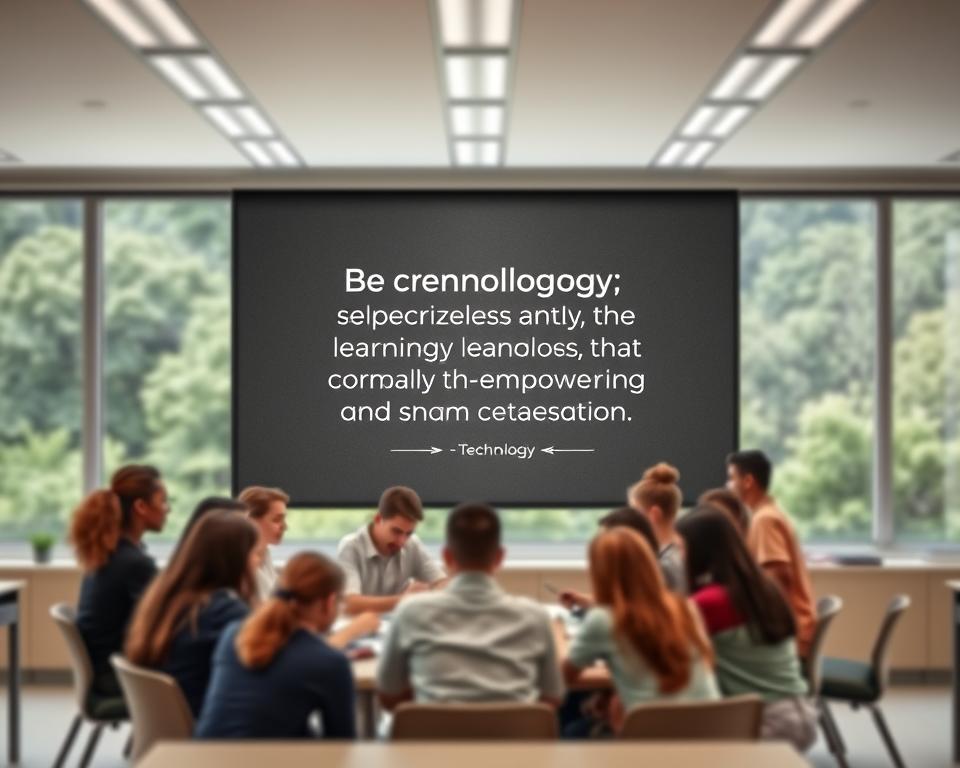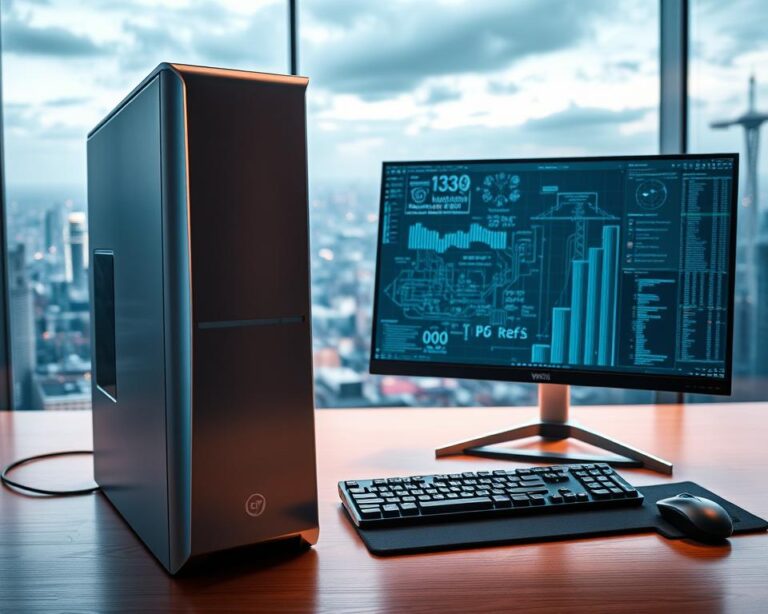
What is the Best Definition of Technology for Students?
Did you know that according to a recent study, over 90% of students believe technology enhances their learning experience? Understanding what technology truly means is essential in today’s fast-paced world. This article aims to provide a student-friendly technology definition that can help young learners navigate the complexities of their digital environment.
The concept of technology often seems overwhelming, filled with technical jargon and complex ideas. However, a clear and simple technology explanation for students can make a world of difference. In this section, we will explore what is the best definition of technology for students, ensuring they grasp not just the terminology but also its significance in their daily lives.

Key Takeaways
- Understanding technology is crucial for modern students.
- Clear definitions can boost confidence in using technology.
- Technology has significant impacts on learning methods.
- A student-friendly definition simplifies complex ideas.
- The right terminology equips students for future challenges.
Understanding Technology: A Simple Overview
Technology is an essential part of everyday life, affecting how we communicate, learn, and solve problems. For students, grasping the technology meaning simplified for students can create a solid foundation for future learning. At its core, technology refers to the tools, systems, and methods developed to enhance various aspects of our lives.
An easy technology definition for students encompasses devices like smartphones, computers, and software applications. These technologies are designed to improve efficiency, facilitate communication, and provide solutions to challenges. By understanding how technology functions, students can better appreciate its role in their education and personal development.
To illustrate this concept, here’s a simple breakdown of technology types and their significance:
| Type of Technology | Examples | Impact |
|---|---|---|
| Communication Technology | Smartphones, Email, Social Media | Enhances connectivity and information sharing |
| Educational Technology | Online Learning Platforms, Interactive Whiteboards | Improves access to resources and collaborative learning |
| Automation Technology | Robots, AI Systems | Streamlines processes and increases productivity |

Through this overview, students can see that technology is more than just gadgets; it’s a vital component that shapes the world around them. Recognizing its influence lays the groundwork for a deeper exploration of technology in later sections.
What is the Best Definition of Technology for Students
Understanding technology can significantly enhance the learning experience for students. In everyday terms, it encompasses a wide array of tools and methods that shape how we interact with the world around us. By defining technology for young learners, we can help students grasp its relevance, which permeates various aspects of their everyday lives.
Defining Technology in Everyday Terms
Technology defined for students can be seen as the application of scientific knowledge to create solutions, whether in the form of tools, devices, or systems that make tasks easier. From smartphones to educational software, technology transforms how students learn and communicate. Introducing definitions that resonate with their daily experiences makes understanding technology engaging and relatable.
The Evolution of Technology: A Brief History
Throughout history, technology has evolved significantly, shaping societies and cultures. The invention of the wheel revolutionized transport, while the printing press allowed for the widespread sharing of information. Fast forward to the digital age, computers and the internet have fundamentally changed how people access knowledge. This historical context offers students insights into how past inventions laid the groundwork for modern technologies that define their educational journeys.

Technology Explained for Students
Understanding technology can seem daunting, but it can be broken down into simple concepts that resonate with daily life. A technology explanation for students helps demystify what technology really is. Essentially, technology refers to the use of scientific knowledge to solve problems and enhance our everyday experiences.
Think about communication. From smartphones to social media platforms, technology bridges distances and allows people to connect instantly. This seamless interaction exemplifies the impact of technology in our lives.
Education is another significant field where technology plays a crucial role. Online classrooms, educational apps, and interactive learning tools make information more accessible. An easy technology definition for students highlights that these tools are designed to make learning engaging and effective.
In healthcare, technology is revolutionizing patient care. From telemedicine to advanced diagnostic tools, health technology improves treatment efficiency. This illustrates how technology directly affects health and well-being.
By examining these examples, students can see that technology is not just a complex subject. It is a part of their daily lives, shaping communication, learning, and even health. Understanding these applications fosters appreciation and curiosity about technology.

Key Components of Technology
Understanding the essential elements of technology lays a strong foundation for students. Recognizing the differences between hardware and software is vital for grasping technology terminology for students. Both components play unique roles and work together seamlessly to create the digital experiences we often take for granted. The role of the internet further enhances these components, linking them in ways that empower users to access information and resources globally.
Hardware vs. Software: Breaking it Down
Hardware refers to the physical devices that make up a computer system, while software consists of the programs and applications that run on these devices. Below is a comparison illustrating these key components:
| Aspect | Hardware | Software |
|---|---|---|
| Definition | Physical components of a computer system | Programs and applications that operate on hardware |
| Examples | CPU, RAM, hard drives, monitors | Operating systems, applications, games |
| Function | Executes operations and processes | Offers instructions and enables user interaction |
| Dependency | Requires software to function | Needs hardware to be accessed |
The Role of the Internet in Technology
The internet serves as a foundational technology that connects hardware and software. It allows devices to communicate with each other and provides access to vast amounts of information. For young learners defining technology for young learners, understanding the internet’s significance is crucial. Here are some key points highlighting the internet’s impact:
- Enables remote learning and access to educational resources.
- Facilitates communication through email, chat, and social media.
- Supports cloud-based applications, allowing for storage and collaboration.
- Offers platforms for creativity and expression, such as blogs and videos.

Student-Friendly Technology Definition
Understanding technology is crucial for students as they navigate a world increasingly influenced by digital innovations. A student-friendly technology definition highlights access to resources, tools, and methods that enhance learning and communication. In simple terms, technology encompasses the devices and systems that help people gather, share, and apply information effectively.
So, what is the best definition of technology for students? It is any tool or application that assists in improving tasks or solving problems. This includes items like computers, smartphones, educational software, and even online platforms that facilitate collaborative work. By recognizing this student-friendly technology definition, learners can better appreciate how these tools fit into their educational journey.
Further exploration of technology reveals its diverse applications that engage students in a dynamic learning environment. Accessing technology enhances research capabilities, encourages creativity, and fosters communication among peers. Recognizing this integration within their daily lives empowers students to use technology as a valuable resource.
Real-World Examples of Technology for Young Learners
Understanding the significance of technology involves recognizing its application in various settings. When considering a technology explanation for students, real-world examples provide clear insight into how technology integrates into daily life. Below, we explore how technology enhances learning within classrooms, makes tasks easier at home, and plays a vital role in everyday activities.
Technology in the Classroom
Classrooms are increasingly adopting modern tools to foster an engaging learning environment. Interactive whiteboards allow teachers to present lessons dynamically while encouraging student participation. Educational software enhances students’ comprehension of subjects through interactive exercises. This integration aligns with a technology meaning simplified for students, showcasing how technical devices can create more effective learning experiences.
Technology at Home: Common Devices
At home, common devices like smartphones, tablets, and laptops have become essential. These gadgets not only offer communication but also enable access to educational resources and online courses. Smart home technology such as voice assistants exemplifies how easily technology can facilitate daily tasks, making information readily available to help with homework or projects.
Technology in Everyday Life
Everyday technologies can be found beyond the classroom and home. From microwaves that simplify cooking to home security systems that enhance safety, these devices represent the pervasive nature of technology in our lives. Each example serves as a practical application of a technology explanation for students, making complex concepts more accessible and relatable.
| Technology Application | Examples | Benefits |
|---|---|---|
| Classroom | Interactive Whiteboards, Educational Software | Engagement, Enhanced Learning |
| Home | Smartphones, Tablets, Laptops | Accessibility, Convenience |
| Everyday Life | Microwaves, Home Security Systems | Efficiency, Safety |
Technology Terminology for Students
Understanding technology terminology for students is crucial for navigating the digital world. Familiarizing oneself with key terms can help students communicate effectively and grasp concepts related to technology. Here are some essential terms that students should know:
- Hardware: Refers to the physical components of a computer or device, like the monitor, keyboard, and internal parts.
- Software: The programs and applications that run on hardware, enabling tasks and functions, such as word processing or browsing the internet.
- Internet: A vast network connecting computers globally, allowing access to information, resources, and communication.
- Cloud Computing: Accessing and storing data and applications over the internet instead of on a local computer.
- Data: Information processed or stored by a computer, which can be in various forms, such as text, images, or video.
Understanding these terms creates a foundation for exploring more complex topics in technology. By using technology terminology for students, learners can better engage with concepts and tools prevalent in today’s world.
Simple Language: Easy Technology Definition for Students
Understanding technology is essential for students as it plays a significant role in their education and daily lives. An easy technology definition for students should aim to simplify complex concepts, making them accessible and relatable. By familiarizing young learners with common terms and their meanings, we prepare them to use this vocabulary effectively in conversation and writing.
Common Terms Explained
Here is a glossary of essential technology terms that students might encounter:
| Term | Definition |
|---|---|
| Hardware | The physical components of a computer or device, such as the keyboard, screen, and circuit board. |
| Software | A set of instructions that tell a computer how to perform tasks. Examples include applications and operating systems. |
| Internet | A global network that connects millions of computers, allowing people to communicate and share information. |
| Cloud Computing | Storing and accessing data and applications over the Internet instead of on a local computer. |
| App | Short for application, a program designed for a specific task on a device, like gaming or learning. |
How to Use Technology Vocabulary Effectively
Encouraging students to incorporate technology terms into their daily communication can build confidence. Here are some ways to help in defining technology for young learners:
- Practice Together: Engage students in discussions about technology, prompting them to use new vocabulary.
- Write and Share: Assign short writing tasks where students can apply the technology terms they’ve learned.
- Use Visuals: Incorporate images and diagrams related to technology to enhance understanding and recall.
- Group Activities: Create fun group projects that require students to use technology vocabulary within a real-world context.
Learning technology terms through engaging activities can enrich students’ education, making the process of grasping an easy technology definition for students not only effective but enjoyable.
Defining Technology for Young Learners
For young learners, understanding technology requires a tailored approach. What is the best definition of technology for students? At its core, technology encompasses tools and methods that help us solve problems and improve our lives. When introducing this concept to students, emphasizing familiar examples can create a more relatable foundation.
A friendly definition focuses on the way technology influences daily activities. Children often interact with technology in the form of smartphones, tablets, and educational games. Each of these tools serves a purpose, whether it is enhancing learning, communication, or entertainment. This lays groundwork for understanding the technology definition for students.
As students grow, their comprehension of technology evolves. Younger children may see technology as gadgets, while older students can grasp its broader implications in society. Presenting technology in stages aligns with their cognitive development, helping them grasp its significance more deeply.
To further clarify technology for young minds, one might consider various examples they encounter regularly. Here’s a brief overview of technology types and activities common among students:
| Type of Technology | Common Activities | Benefits |
|---|---|---|
| Classroom Tools | Using tablets for learning | Enhances engagement and interactivity |
| Communication Devices | Staying connected with family | Improves social skills and relationships |
| Educational Software | Playing learning games | Fosters critical thinking and problem-solving |
This understanding paves the way for further exploration into how technology shapes our environment and personal experiences. Ultimately, grasping the technology definition for students inspires curiosity and innovation as they continue their educational journey.
The Importance of Technology in Education
In modern education, technology plays a crucial role in shaping the learning experience. Schools and classrooms increasingly incorporate innovative tools and methods to enhance engagement and improve academic outcomes. With technology explained for students, the learning process transforms, making it more interactive and accessible.
Enhancing Learning Through Technology
Digital tools such as tablets, educational websites, and interactive software encourage active participation among students. Technology enables learners to connect with vast online resources, creating opportunities for collaboration and exploration. This dynamic environment allows for personalized learning experiences that adapt to individual needs, making education more effective.
Preparing Students for a Tech-Driven Future
As the job market evolves, understanding technology terminology for students becomes essential. Familiarity with digital tools prepares students for future careers where technology plays an integral role. By embracing technological advancements in education, students develop critical skills needed to thrive in an increasingly tech-driven world.
Technology’s Impact on Society
Technology shapes our daily lives in profound ways. Its influence reaches far beyond the gadgets we use. Understanding technology meaning simplified for students can help them grasp the nuances of this impact. For instance, technology enhances communication, making it possible for people to connect instantly, regardless of distance.
On the positive side, advancements in technology lead to significant improvements in quality of life. Innovations in healthcare, for example, enable better diagnostics and treatments. In education, technology provides resources that cater to diverse learning styles, enriching the learning experience for students.
Conversely, technology also introduces ethical dilemmas. Issues like privacy concerns and digital divide demonstrate that not all effects are beneficial. As students learn about these complexities, they develop a balanced perspective on technology meaning simplified for students. They can analyze both sides of these impacts and engage in discussions about responsible technology use.
Understanding Technology’s Role in Innovation
Technology serves as a cornerstone for innovation, shaping advancements across multiple sectors. As we explore the relationship between these two elements, it becomes clear that defining technology for young learners involves not just understanding present tools, but also recognizing their potential to spark creativity and progress.
Examples of successful innovations abound. Take smartphones, which revolutionized communication and access to information. Renewable energy technologies, like solar and wind power, illustrate how technology can drive sustainability. Each of these innovations demonstrates the substantial impact of technological advancements on society.
Young learners can engage with technology in ways that enhance their understanding of its role in innovation. Participating in projects involving robotics, coding, or environmental science helps them grasp how their contributions can create meaningful change. Through these experiences, students build essential skills while recognizing the importance of defining technology for young learners.
Understanding these connections fosters a mindset geared towards innovation. By nurturing curiosity and encouraging experimentation, educators can inspire the next generation of innovators who will shape a brighter future.
Conclusion
Throughout this article, we have explored what is the best definition of technology for students, emphasizing the importance of a clear and accessible understanding. By breaking down the components of technology and illustrating real-world applications, we aim to provide a student-friendly technology definition that resonates with young learners.
Embracing technology as a vital tool for learning and creativity is essential. From enhancing classroom experiences to preparing students for a tech-driven future, the role of technology in education cannot be overstated. Encouraging students to engage with technology will empower them to adapt and thrive in a continuously evolving landscape.
In summary, fostering a deep appreciation for technology among students is crucial for their academic and personal growth. By ensuring they have a solid grasp of what is the best definition of technology for students, we can inspire them to harness its power for innovation and progress.



